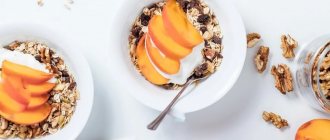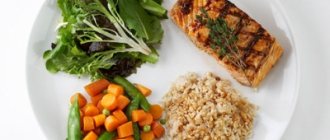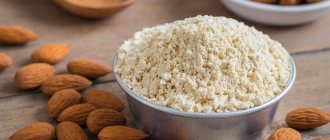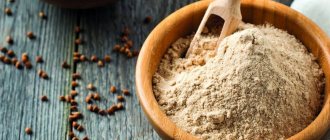Flour is not flour, but flour without flour is flour. Wheat, rye, corn, oatmeal, rice...
Flour is a powder that is obtained by grinding cereal grains. The first devices for its manufacture date back to the fourth millennium BC. Primitive people crushed grains using stones. Much water has passed under the bridge since then, but humanity still cannot imagine its existence without cereals, flour and bakery products.
We are accustomed to baked goods and dishes made from traditional wheat flour. However, in the countries of Southeast Asia, Japan, and China, the most popular is chapsari (another name is rice flour), which is obtained by grinding polished white or brown rice.
Rice flour in baby food: benefit or harm
Manufacturers include it in infant formulas and cereals. Firstly, it has the property of a thickener that will not cause the slightest harm to the child’s body. Secondly, it promotes the breakdown of fructose into glucose, preventing digestive disorders due to the high content of natural sugars in fruit mixtures. And thirdly, it promotes better absorption of beneficial substances obtained by consuming mixtures.
Today, the overwhelming number of foreign manufacturers use the product in the production of baby food, but only a few use it on the domestic market. However, the absence of harm and risks of rice flour for infants, as well as a number of beneficial properties, contribute to its popularization as an ingredient in baby food among domestic manufacturers.
Chemical composition of rice flour
The most common types are brown and white. The health benefits of brown rice come from the fact that the husk remains on the grain, providing more fiber and several other beneficial nutrients.
| Compound | From white rice | From brown rice |
| Manganese | 1.2 mg | 4 mg |
| Vitamin B6 | 0.44 mg | 0.7 mg |
| Selenium | 15.1 mcg | — |
| Niacin | 2.6 mg | 6.5 mg |
| Thiamine | 0.13 mg | 0.45 mg |
| Phosphorus | 98 mg | 337 mg |
| Magnesium | 35 mg | 112 mg |
| Pantothenic acid | 0.8 mg | 1.6 mg |
| Copper | 0.13 mg | 0.26 mg |
| Zinc | 0.8 mg | 2.5 mg |
| Iron | 0.35 mg | 2.0 mg |
| Potassium | 76 mg | 289 mg |
| Vitamin E | 0.11 mg | 1.2 mg |
| Kholin | 5.8 mg | — |
Thus, brown grinding brings greater benefits and, accordingly, costs more.
Rice flour is gluten-free: it is an excellent substitute for wheat flour, which can be harmful to the body due to its gluten content, a protein that can irritate the digestive system. It is an excellent thickener and is perfect for making soups, sauces and gravies, and is often used to make flour products.
We recommend reading: Gluten: what it is and why it is harmful, where it is found, symptoms of intolerance
However, despite a rather impressive list of useful properties and advantages, it lacks the nutrients that are found in more traditional varieties, and under certain conditions it can even cause harm to the body.
Calorie table for different types of flour
The calorie content of flour and BJU (proteins/fats/carbohydrates) varies depending on the type of product.
To select low-fat flour that is suitable for diabetics or obese patients, it is necessary to consider the beneficial properties
Common types with nutritional value:
| View | Calories (100 g) | BZHU (100 g) |
| Wheat (highest grade) | 339 | 11/1,4/70 |
| Wheat (coarse grind) | 312 | 11/1,5/65 |
| Wheat (whole grain) | 302 | 13/1,5/58 |
| Rye | 295 | 12/2/35 |
| Coconut | 456 | 20/15/60 |
| Almond | 606 | 26/54,5/13 |
| Rice | 365 | 6/1,5/85 |
| Corn | 325 | 7/2/76 |
| Oatmeal | 375 | 12/6/60 |
| Barley | 300 | 9/1/60 |
| Linen | 273 | 36/10/5 |
| Chickpeas | 389 | 22,2/7/58 |
| Buckwheat | 349 | 13,8/1/,72 |
| Pea | 292 | 9/1,7/61 |
| Pumpkin | 301 | 33/9/22 |
| Spelled | 150 | 12,/0,7/25 |
| Cheremukhovaya | 120 | 7,8/0/21 |
| Amaranth | 293 | 9/1,7/60,5 |
| Sesame | 468 | 46/12/30 |
Low-calorie varieties are bird cherry and spelled. If you are more used to wheat, it is recommended to use the whole grain variety.
Contents of the BZHU
BJU is the ratio of substances such as fats, carbohydrates and proteins in a product. Based on the calculation of this ratio, a diet and proper nutrition are compiled taking into account the needs of the body.
The main types of flour have the following ratio of BZHU (per 100 g):
- Wheat flour contains the most carbohydrates - 76%. In 2nd place are proteins – 10%, and in 3rd place are fats – 1%.
- Oatmeal contains 64% carbohydrates, 12.2% protein and 7.5% fat.
- Rye – 64% carbohydrates, 8.7% proteins, 1.7% fats.
- Rice contains 77.7% carbohydrates, 6.8% proteins, 0.8% fats.
- Corn – 71% carbohydrates, 8.2% protein and 1.9% fat.

- Buckwheat – 64% carbohydrates, 16.3% proteins and 3.5% fats.
- Barley flour contains 69.9% carbohydrates, 10.3% proteins, 1.1% fats.
- Soy flour contains only 24.2%, and the largest amount of proteins (of the presented types of flour) – 46.5%. Fats account for 11.2%.
- Pea flour contains 21.8% carbohydrates, 7.6% proteins, and is completely free of fat.
- Flaxseed flour contains the least amount of carbohydrates – 12.63%. The protein content is 31.94% and fat content is 12.41%.
What flour is good for diabetics and those losing weight?
To choose low-fat flour suitable for patients with diabetes or obesity, you need to consider the beneficial properties:
- soy – contains protein, strengthens bone and cartilage tissue, muscle corset;
- corn - contains vitamins A and E, improves bile flow, stabilizes the gastrointestinal tract, makes the vessels and arteries of the heart muscle strong and durable;
- buckwheat – stabilizes the amount of glucose in the blood;
- oatmeal – lowers cholesterol, normalizes stomach function;
- flaxseed – cleanses of decay products, toxins, starts accelerated food processing, promotes weight loss;
- coconut – accelerates the breakdown of fat cells, gives a feeling of fullness and suppresses hunger, fights constipation and stabilizes the gastrointestinal tract;
- almond – lowers cholesterol, triggers the body’s natural production of insulin, cleanses the kidneys, protects blood vessels, prevents the absorption and deposition of carbohydrates.
Advice! It is recommended to exclude wheat variety from the diet, replacing it with whole grain bran.
How many calories are in flour
You probably don't wonder how many calories are in flour when you're cooking, right? It so happens that we are more often worried about the calories in a Charlotte or Big Tasty burger than in flour. Of course, no one would think about how many calories are in tea or a cappuccino coffee drink, and the reason for this is the belief that the drinks are completely calorie-free, and even if there are calories, they are few. Indeed, there are very few of them there, but the same cannot be said about flour.
Many women and girls have been accustomed to using wheat flour since Soviet times, because, basically, only this product could be found on store shelves. But in our time, everything has changed, and there is an incredible variety of different types of flour, the calorie content of which we will talk about below.
Is there a type among them that could replace wheat flour, cook delicious cakes with it, and at the same time lose weight? Yes, there definitely is! And what kind of species this is, you will find out below!
Wheat
Wheat flour is a product that every housewife has in her home. It is made from wheat grains, has a slight smell of bread and does not have any distinct taste at all. Its calorie content per 100 grams is 364 kcal.
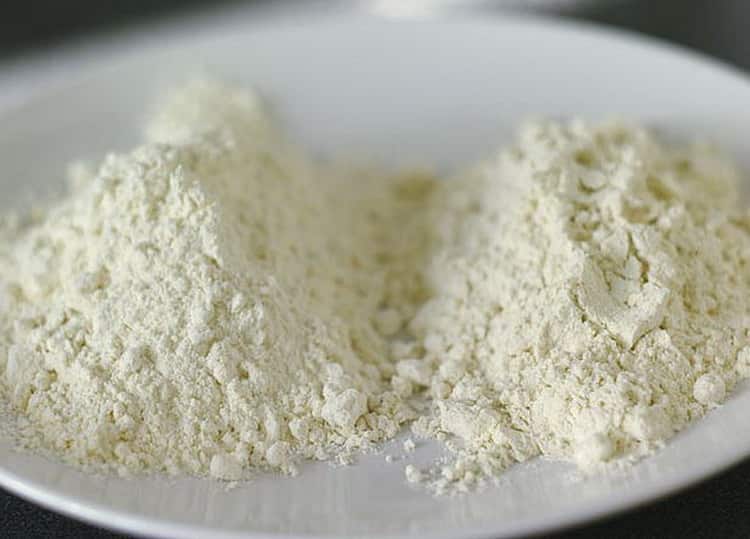
Oat
Oatmeal is usually called medicinal, because the oats from which it is made provide the body with many useful vitamins and minerals. This flour is used to prepare PP cakes, pastries and other flour sweets (PP from the phrase “proper nutrition”) - such desserts are those that have a completely natural composition, without chemical additives, and with a minimum amount of calories. And although the calorie content of oat flour is not much different from wheat flour - 369 kcal per 100 grams, it has much more benefits.
Rice
This type is also used in preparing “proper” dishes. It does not contain gluten, which means it can be safely consumed by people with allergies. This type is mainly common in Asian countries, but in recent years this flour has also begun to gain popularity here. Its calorie content per 100 grams is 366 kcal.

Corn
There are different versions of this flour, in some the calorie content per 100 grams is 370 kcal, in others - 330 kcal. Of course, if you see the second option on the counter, buy it without hesitation. There is not much difference between them, even if you take the higher calorie option. The fact is that corn flour retains a maximum of its beneficial components, and it is often recommended to be used in cooking for those who are on a diet due to illness or are losing weight. It is also called diet flour.
Wholegrain
This is a subtype of wheat flour that contains fewer calories than regular flour. This is approximately 340 kcal per 100 grams. This product is used to make whole grain bread and crispbreads, which are considered very healthy. They retain a maximum of substances that the body needs for normal functioning. For diet and proper nutrition, this option is definitely suitable.
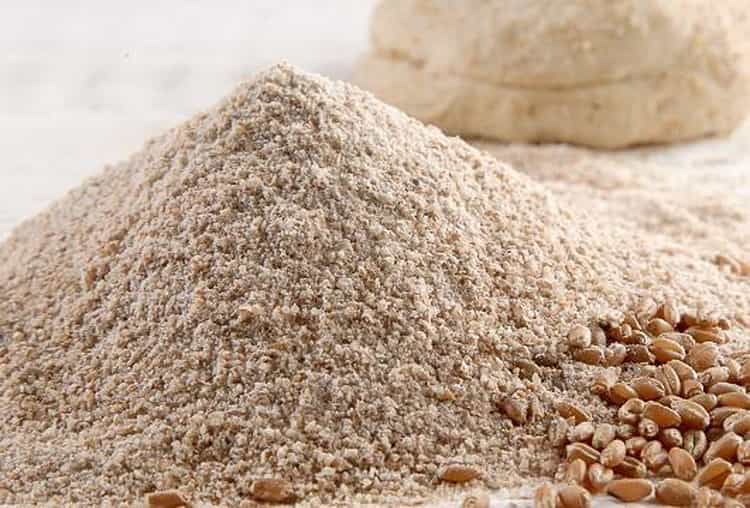
Linen
This option is considered very low-calorie, and at the same time, very healthy. The calorie content per 100 grams of flaxseed flour will be 270 kcal, and the composition contains vitamins such as A, H, E, D and the entire group of vitamins B. In addition, the composition also contains healthy fatty acids, including Omega-3 and Omega-6. An excellent choice for those who are losing weight and maintaining a healthy diet.
Rye
Everyone knows that rye bread is very healthy because it contains many vitamins and minerals. It is made from rye flour, which means it will have a beneficial effect on the human body if you make pies or cakes from it. Calorie content per 100 grams is 349 kcal.
Why do I have colored and black and white dreams?

Buckwheat
Like the options described above, buckwheat flour is also actively used in dietary nutrition. It contains many vitamins, as well as iron, iodine, potassium and other useful compounds. Its calorie content per 100 grams is 353 kcal.
Coconut
Have you ever heard that coconut is used to make flour? Yes, indeed, this type also exists. Coconut flour is very similar to wheat flour in consistency, but it contains much more useful components than the usual version. However, the calorie content of coconut flour is very high - 466 kcal per 100 grams. Despite the fact that this is a fairly large indicator, this type still remains one of the most useful, even on a diet.

Almond
This option is very expensive, but very tasty and healthy. The famous French macarons cake is made from this flour, and believe me, you simply cannot recreate this unique taste with any other flour. The calorie content of almond flour is 602 kcal per 100 grams. Yes, the number of calories is crazy, but there will definitely be benefits from this product. And it lies in the fats that this flour contains. But, unfortunately, it is not recommended to be consumed as part of a diet.
Soy
Like any soy product, this flour is useful for those who have intolerance to all other types or an increased allergic reaction. There are two subtypes - low-fat soy flour and non-defatted soy flour. Of course, both options are suitable for dietary nutrition, but one simply contains fewer calories, while the other contains more. Low-fat soy flour has 299 kcal, and non-defatted soy flour has 385 kcal.
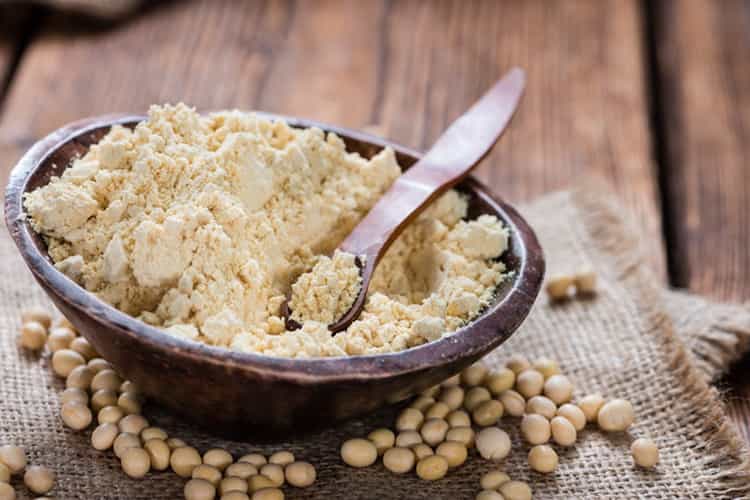
| Type of flour | Calorie content per 100 g |
| Wheat | 364 kcal |
| Oatmeal | 369 kcal |
| Rice | 366 kcal |
| Corn | 330-370 kcal |
| Whole grain | 340 kcal |
| Linen | 270 kcal |
| Rye | 349 kcal |
| Buckwheat | 353 kcal |
| Coconut | 466 kcal |
| Almond | 602 kcal |
| Soy | 299-385 kcal |
Types and varieties of flour
Flour is distributed according to several indicators:
- Type – determines the purpose of using flour. It can be bakery (rye and wheat flour from soft wheat, a mixture of different types of flour), confectionery and pasta flour (made from durum wheat).
- The type of flour is determined by the plant crop (mainly cereal plants) from which it was made. The most common flours are wheat, barley, rye, buckwheat, pea, rice and other types of flour.
- The grade is determined by the amount of flour that was obtained from 100 kg of grain raw materials. This means that the lower the grade of the product, the greater its yield.
The table below shows the existing varieties of wheat flour:
| Variety | Product Features |
| Krupchatka | Contains at least 30% gluten, has a grain size from 0.16 to 0.20 mm. Flour is white or creamy with a yellowish tint. It is added to the dough dough to give the product porosity. |
| Higher | Contains at least 28% gluten. The product is made from the core of the grain (without the outer shell). Premium flour is used to make most baked goods and is also added to sauces and creams. |
| First | Contains at least 30% gluten. It is used in the preparation of noodles, pies, savory buns, and pancakes. |
| Second | The flour turns out brown due to the fact that it contains a lot of the outer shell of wheat. |
| Whole wheat flour | The product is obtained by grinding unrefined grains. The flour particles are heterogeneous and large. Contains the highest amount of useful substances. |
Product calculator
Enter the amount of Rice Flour to calculate its nutritional value
| Property | Meaning | % of normal | |
| Calorie content, kcal | 366 | 18.3 | 18.3% |
| Proteins, g | 5,95 | 3.33 | 3.33% |
| Carbohydrates, g | 77,73 | 30.8 | 30.8% |
| Fats, gr | 1,42 | 2.27 | 2.27% |
Why is white wheat flour harmful?
Wheat flour does more harm than good. Regardless of the variety, it does not exclude dietary fiber, affects health and leads to weight gain.
This simple, refined product contains gluten, a protein derivative of gluten, which glues the contents of cereals together and causes diseases.
Note! With regular consumption of dough made from premium flour, people may eventually develop celiac disease, that is, gluten intolerance, for this reason it is important to reduce the frequency of their use and monitor nutrition.
The gluten content will depend on the variety and grinding of the product: usually it is higher in premium varieties.
Daily volume of flour consumption on a diet
A person who does not have health problems, but wants to lose a few extra pounds, should consume up to 150 g of flour products per day. At the same time, a single serving containing flour products should not exceed 50 g.
Here are some tips to help you lose weight:
- Flour products are best consumed in the first half of the day.
- It is recommended to combine flour dishes with vegetables and dairy products.
- It is undesirable to simultaneously eat flour products along with cereals, fatty dairy products, and vegetables containing a lot of starch.
- The combined consumption of flour with sweet dishes, pickled and salted vegetables, as well as protein products is prohibited.
- Do not give up eating flour products - the substances they contain cannot be replaced with other food products.
What to cook with flour
You can prepare many different dishes from flour, but we decided to tell you about the simplest ones. You can easily prepare any of these dishes yourself; to do this, choose the flour you like and follow our recipes. Bon appetit!
Pancakes
Calorie content: 227 kcal per 100 grams.
| Milk | 2.5 glasses |
| Flour | 1.5 cups |
| Eggs | 2 pcs. |
| Sugar | 1 tsp. |
| Salt | 0.5 tsp. |
| Vegetable oil | 3 tbsp. l. |
Cooking process:
- Mix milk, eggs, sugar and salt with a mixer.
- Add butter and continue beating with a mixer until smooth.
- Add flour and mix well.
- Fry in a frying pan with a little oil on both sides for 1-2 minutes.
- Ready! Serve with jam, condensed milk or sour cream!

Cupcakes
Calorie content: 300 kcal per 100 grams.
| Cocoa | 2 tbsp. l. |
| Milk | 5 tbsp. l. |
| Sugar | 4 tbsp. l. |
| Flour | 4 tbsp. l. |
| Baking powder | ¼ tbsp. l. |
| Vegetable oil | 3 tbsp. l. |
| Vanilla sugar | taste |
| Eggs | 1 PC. |
Cooking process:
- Beat egg, sugar and vanilla sugar with a fork.
- Add milk, butter and baking powder. Mix well.
- Gradually add flour and cocoa, stirring.
- Pour into molds and place in an oven preheated to 180 degrees.
- In 6-7 minutes the cupcakes are ready!
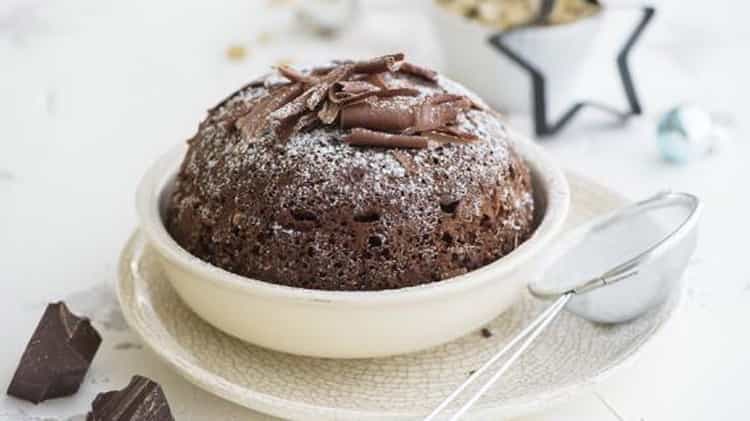
Flatbread
Calorie content: 226 kcal per 100 grams.
| Flour | 1 kg |
| Salt | 1 tbsp. l. |
| Yeast | 2 tbsp. l. |
| Water | 200 ml |
Cooking process:
- Sift the flour and prepare the yeast. To do this, mix the yeast with 2 tablespoons of flour and dilute in ½ cup of warm milk (or water). Place the finished mixture in a warm place and wait for it to rise.
- When the mixture rises, add the remaining water, salt and flour. Cover with a towel and let the dough rise.
- When the dough is ready, you need to grease it on both sides with oil and put it in the oven, tightly covering the top with something heavy (a frying pan, for example).
- Bake at 200 degrees for 10 minutes, then remove, turn over, cover with a frying pan and bake for another 10 minutes.
- Ready!
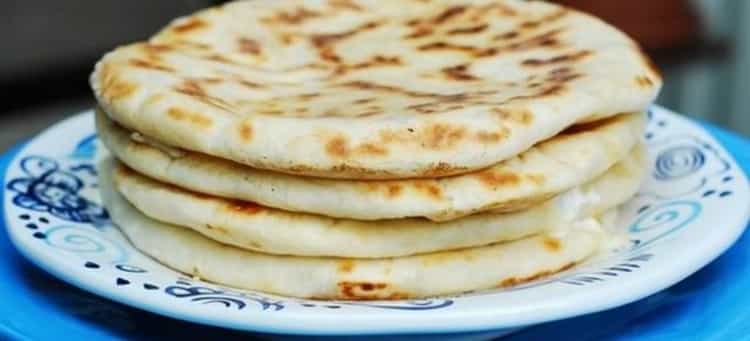
Cheesecake recipe
The recipe for making curd cheesecakes from rice flour is simple and does not require special skills. The dish turns out very tasty and appetizing.
How nutritious are cheesecakes made from rice flour?
- calorie content per 100 grams - 145.1,
- carbohydrates - 11.2 grams,
- fats - 2.9 grams,
- proteins - 18.9 grams.
To prepare the dish you will need:
- cottage cheese (fresh, medium fat content) - two packs of 200 grams each,
- chicken eggs - 2 pieces,
- rice flour - 5 or 6 tablespoons,
- granulated sugar - 5 or 6 tablespoons,
- vanilla sugar - 1/3 teaspoon,
- lemon - 1 piece,
- Sunflower oil - 2 tablespoons.

Wash the lemon, carefully grate the yellow skin (zest) finely.
Place the cottage cheese in a container, knead well, add granulated sugar, vanilla, lemon zest. Mix everything, beat in the eggs, mix well again. Add rice flour. Knead the resulting mixture thoroughly. All ingredients can be mixed using a blender.
Make cheesecakes from the resulting dough. Heat a frying pan, grease it with oil, fry the pieces on both sides until golden brown. Before serving, dry the cheesecakes (if necessary) to remove excess oil with a paper towel. Serve the dish with sour cream, jam, condensed milk or berries.
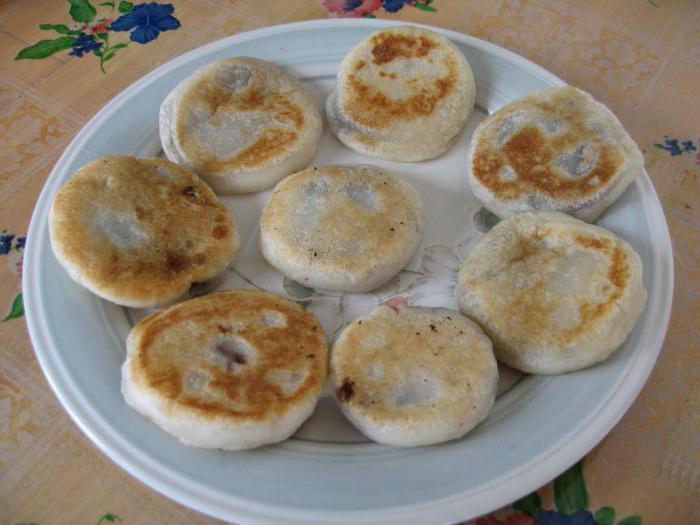
Application in cosmetology
Using rice flour, you can make various whitening and cleansing masks and scrubs. It is often used to remove freckles and age spots. Its successful use in the field of cosmetology is primarily due to the fact that rice is a natural antioxidant and is able to absorb and remove harmful and dangerous substances from the body. It is also able to maintain water-salt balance and remove excess fluid. Such properties are simply irreplaceable in the cosmetics industry.
Rejuvenating face mask
The use of this product will tighten the skin, prevent the appearance of wrinkles, and improve tone. After such a mask, it will look smooth and elastic.
For the mask you will need:
- rice flour – 1 teaspoon;
- sour cream – 1 dessert spoon;
- mixture of egg yolk and white - 1 teaspoon.
Mix all ingredients until a homogeneous mass appears. Apply to previously cleansed facial skin, hold for 20 minutes, and after finishing the procedure, rinse with warm water.
Body scrub with rice flour
To prepare you will need:
- rice flour;
- ground coffee.
Mix the ingredients in equal parts and dilute with milk to the consistency of thick sour cream. Apply the product to the body from bottom to top, delicately rubbing the skin with soft circular movements. Do not tear or scratch the skin under any circumstances. After 15-20 minutes, rinse off any remaining product under a warm shower.
Walnuts with honey: benefits and harms
After this procedure, the skin will glow, become tightened and more elastic.
The nutritional value
Rice flour, the benefits and harms of which are completely justified and argued, is considered a fairly high-calorie product. The nutritional value and calorie content of white and brown rice are slightly different.

| Kcal (per 100 g) | Carbohydrates | Squirrels | Fats |
| White flour – 366 kcal | 80 g | 5.9 g | 1.4 g |
| Brown flour – 360 kcal | 76.5 g | 7.2 g | 2.8 g |
Fiber content per 100 g: white flour – 2.4 g, brown flour – 4.6 g.
Use in home medicine
Rice flour has also found its use in folk medicine. In Asia, products based on this cereal have been used for a long time, knowing its beneficial healing qualities. In Japan, it is believed that if you eat two tablespoons of raw rice or flour made from this cereal at breakfast, you can get rid of significant intestinal problems and forget about abdominal pain.
A compress of boiled rice flour and vinegar is used for bruises, sprains and insect bites. And hard-boiled rice water without adding salt is an excellent remedy for diarrhea. To do this, you need to mix rice flour with goat lard and use it as food for chronic stomach and intestinal upsets.
Harm of rice flour and contraindications
Despite all the beneficial properties of grinding, its harm, even potential, has not been recorded. However, it's worth noting that gluten-free foods contain less protein, fiber, and minerals, and have a higher glycemic index than some gluten-containing foods.
Important! Relatively recently, controversy began over the content of arsenic in rice, and, accordingly, the harm of this product to the body. But this information is not documented.
Rice flour has a fairly high glycemic index of 70 units, so you should not consume rice flour if you have diabetes: there is a danger of causing even more harm to the body.
Flour composition
Now is the time to understand the nutritional and energy value of each type of flour. Below is a table with all the data on proteins, fats and carbohydrates.
| Type of flour | Calorie content per 100 g | Proteins +% of normal | Fats +% of normal | Carbohydrates +% of normal | Alimentary fiber |
| Wheat | 364 kcal | 13.2 g (16.1%) | 2.5 g (3.85%) | 61.3 g (47.89%) | 10.7 g (0.42%) |
| Oatmeal | 369 kcal | 13 g (15.85%) | 6.8 g (10.46%) | 64.9 g (50.7%) | 4.5 g (22.5%) |
| Rice | 366 kcal | 6 g (7.32%) | 1.4 g (2.15%) | 77.7 g (60.7%) | 2.4 g (12%) |
| Corn | 330-370 kcal | 7.2 g (8.78%) | 1.5 g (2.31%) | 72.1 g (56.33%) | 4.4 g (22%) |
| Whole grain | 340 kcal | 7 g (8.54%) | 0.6 g (0.92%) | 78 g (60.94%) | 0 g (0%) |
| Linen | 270 kcal | 25 g (30.49%) | 5 g (7.69%) | 40 g (31.25%) | 0 g (0%) |
| Rye | 349 kcal | 10.7 g (13.05%) | 1.9 g (2.92%) | 58.5 g (45.7%) | 13.3 g (66.5%) |
| Buckwheat | 353 kcal | 13.6 g (16.59%) | 1.2 g (1.85%) | 71.9 g (56.17%) | 2.8 g (14%) |
| Coconut | 466 kcal | 3.5 g (4.27%) | 1.5 g (2.31%) | 9 g (7.03%) | 0 g (0%) |
| Almond | 602 kcal | 25.8 g (31.46%) | 54.5 g (83.85%) | 13 g (10.16%) | 0 g (0%) |
| Soy fat-free | 299 kcal | 48.9 g (59.63%) | 1 g (1.54%) | 21.7 g (16.95%) | 14.1 g (70.5%) |
| Soy non-fat | 385 kcal | 36.5 g (44.51%) | 18.6 g (28.62%) | 17.9 g (13.98%) | 13.3 g (66.5%) |
The chemical composition of each type of flour is different, and above we have already described several options for what may be included in this or that flour. Accordingly, depending on its components, each type of flour provides the body with different benefits, but some points are completely the same, so we invite you to familiarize yourself with the benefits of any type of flour for the human body. Here are some important properties of this product:
- stabilizes intestinal function;
- improves immunity;
- improves the functioning of the nervous system;
- saturates the body with vitamins;
- stimulates mental activity;
- improves the condition of hair and nails;
- promotes skin regeneration.
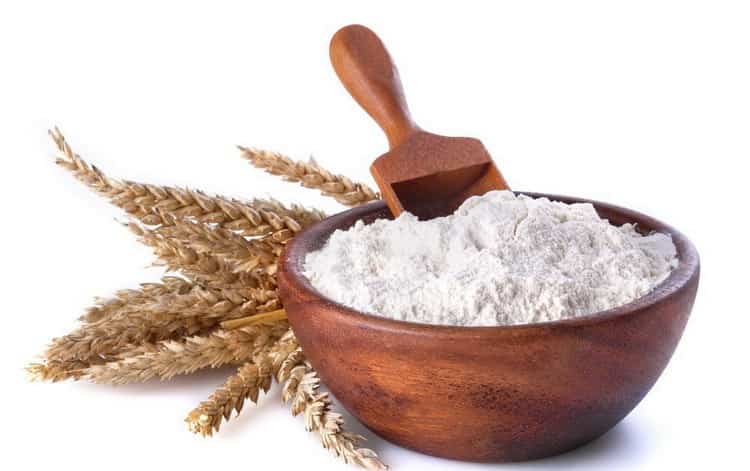
The benefits of whole grain flour (video)
Due to the fact that this type of flour is considered one of the most popular, we suggest you watch the video to understand in more detail why it is useful. Vera Grinchenko is a food technologist with extensive experience in the food industry. She will tell you everything you need to know about whole wheat flour. Enjoy watching!
We analyzed a lot of material and found out a lot of interesting things. It turns out that there are other types of flour that are made from coconut, buckwheat or even almonds. The most interesting thing is that by eating some of them, you can even lose weight! What did you find new in this article? Share your impressions below in the comments!
Author of the publication
Interesting facts about rice

- Rice is a very durable material. During the feud between China and the Mongol tribes during the construction of the Great Wall of China, rice flour was added to the mortar to make it stronger. The same technology was used for many years in the construction of houses and the creation of bricks.
- In health food stores you can find wild black rice flour. You need to understand that this is the name of a plant that actually has nothing in common with the original cereal, so the beneficial properties of rice will not apply to black flour.
- Rice flour has been used as an antibacterial powder for centuries. This tradition was started by geishas, after which it was picked up by aristocrats, artists, and then by all the beauties of Asia. Today, rice flour can be found among the components of powder products. It keeps pores tight, protects the skin from impurities and relieves irritation.
Rice flour is a completely safe and affordable product that will help maintain health and diversify your diet, so try new recipes with pleasure!
How to choose and store correctly
The first thing you should pay attention to when choosing a product in a store is the integrity of the packaging. Deformation may be a sign of product spoilage due to improper storage. It is also necessary to study the manufacturing date of the product. The shelf life of rice flour is no more than six months.
The finished product should be stored in a dry, dark and cool place. It is advisable to use glass containers with a tight-fitting lid for storage.
Terms and conditions of flour storage
To get the maximum benefit from flour, it is necessary to store this product correctly.
Some recommendations will help with this:
- Favorable temperatures range from + 5 to + 18 0C.
- The ideal humidity level is no more than 60-70%. Its high level indoors can cause the development of fungus in the product.
- The formation of condensation should be avoided - it will cause the flour to become damp and mold may appear in it.
- The flour should not be exposed to direct sunlight - it is better to choose a shaded place (for example, a closed cabinet).
- The storage room should be dry and clean, free of foreign odors, since the wheat product tends to quickly absorb them.
- Do not allow changes in temperature and humidity, as the flour may deteriorate.
- The room where flour is stored must be periodically ventilated and cleaned to avoid the appearance of pests.
- After opening the bag, it is best to pour the flour into a glass or metal jar or box that closes tightly. You can also choose fabric or paper bags for storage.
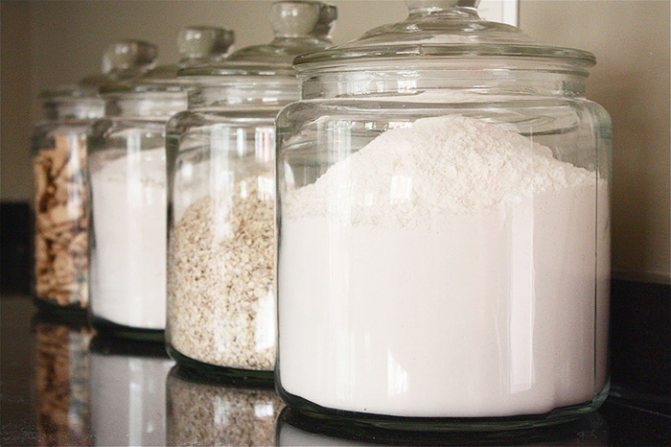
- Storing flour in the refrigerator extends its shelf life.
- It is recommended to periodically inspect the flour - if insects are found, the flour should be sifted and left for listening.
- One of the ways to prevent insects and pests is to place 1-2 unpeeled cloves of garlic in flour.
- If you take flour in your hand and feel cold, this indicates increased moisture in the product. Therefore, it is recommended to dry the flour.
Its shelf life depends on the type of flour, which is presented in the table below:
| Type of flour | Shelf life (in months) |
| Wheat flour (highest grade) | 12 |
| Whole grain wheat | 6-8 |
| Rye | 4-6 |
| Corn (low-fat) | 3-6 |
| Soy (deodorized) | 12 |
| Buckwheat | 7 |
| Barley, rice | 6 |
| Pea | 8-10 |
When pouring flour from the original packaging, it is necessary to put a sticker on the container where it will be stored indicating the expiration date (indicated by the manufacturer on the packaging). After the end of the storage period, it is not recommended to use the product, as it loses its nutritional and quality properties.
Flour contains a large number of useful substances. This is a high-calorie product, but with the right choice of flour, you can create an optimal diet containing healthy flour products.
conclusions
Rice flour today is almost as in demand as wheat or rye flour. Its beneficial properties are valued in the medical industry, cosmetology and cooking. The nutritional value of the product and its ability to cleanse the body of harmful substances and remove excess moisture from it are in demand in dietary programs. One of the main reasons for the popularity of rice flour is its hypoallergenicity, due to the fact that its composition completely lacks a specific plant protein - gluten. Rice flour is used to make excellent desserts and is widely used in the confectionery industry. They make rice bread, rice paper, and rice noodles from it, which are very popular not only in Asian cuisine, but also in Europe. However, there are some contraindications to the use of this product, such as frequent constipation or stomach cramps. Rice flour is also contraindicated for people prone to obesity. But if you use it in moderation, then there is simply no need to talk about harm to the body.
Harm to losing weight
Rice flour is actively used in a healthy diet and, according to nutritionists, is suitable for weight loss.
Due to the absence of gluten (hard-to-digest protein), rice flour is easier to digest by our gastrointestinal tract and generally has a positive effect on the functioning of the digestive system. The product also stimulates intestinal motility, and thanks to the fiber in the composition, it cleanses the body of toxins, wastes and even heavy metal salts. And, as you know, it is problems with the digestive tract and sludge in the body that prevent weight loss.
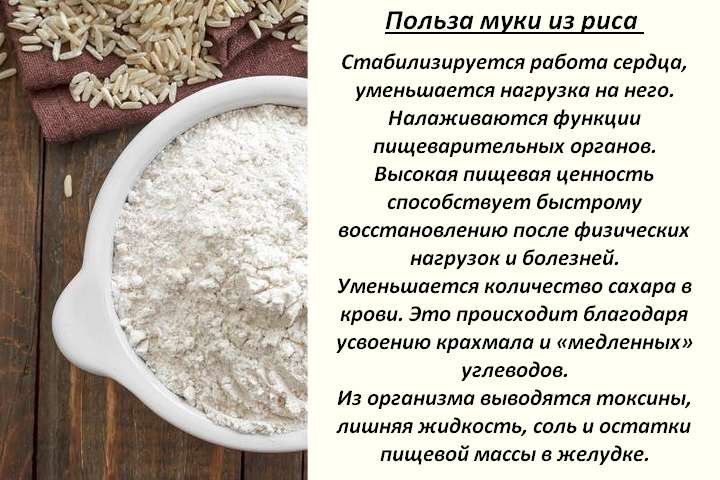
Moreover, eating rice flour helps get rid of puffiness - since the product binds all excess fluid in the body and removes it naturally. Also, this flour contains a minimum of fat (2 times less than wheat flour), but at the same time it perfectly saturates and allows you to maintain a feeling of fullness for a long time.
Rice flour is beneficial for the body as a whole - it helps strengthen bones and joints, has a positive effect on the condition of the skin, nails and hair, and normalizes blood sugar levels. Also, due to the high content of B vitamins, the product brings a lot of benefits to our nervous system.
In addition, rice flour is used in the treatment of diseases of the cardiovascular system, stomach, and is recommended for weakened immunity. It even helps with poisoning! Therefore, the product received praise not only from nutritionists and nutritionists, but also from doctors.

But you should know that rice flour does not only provide benefits. Among the disadvantages, one can highlight the fact that it is still a starchy and high-carbohydrate product - hence the high calorie content. And its excessive consumption will not only affect your figure, but can also lead to constipation and lack of fluid in the body (dehydration).
Interesting: Dietary oatmeal: recipes
